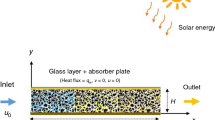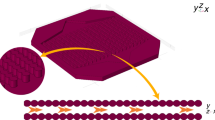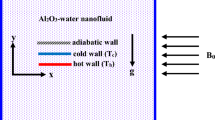Abstract
The investigations show that an undeniable part of future smart energy system, which is to be based on 100% clean energies, is energy storage units. Indeed, due to the intermittent inherent of the main source of renewable energies, e.g., wind and solar, energy storage systems will be highly in service in the future. In this regard, investigation of the impacts of combining nanopowders on the thermal behavior of PCM through a thermal energy storage bed in various operational conditions has been an interesting topic of study in the literature. The current article presents entropy generation assessment of a heat storage unit with a water-based nanoparticle-enhanced PCM under the impact of Lorentz forces. In this system, the nanoparticles are dispersed in the pure phase change material (water) to augment the conductive rate, speeding up the solidification (i.e., the discharging) process. For this, the governing equations are derived with impose of Darcy’s law for the permeable media and homogeneous model for the CuO–water nanomaterial features. The numerical solution method is Galerkin finite element method using FlexPDE software. The results of the simulations are presented for the entropy generation components (including friction, magnetic and thermal effects) and solid fraction contours for various Rayleigh numbers and flow conditions.













Similar content being viewed by others
References
Arabkoohsar A, Ismail KARAR, Machado L, Koury RNNNN. Energy consumption minimization in an innovative hybrid power production station by employing PV and evacuated tube collector solar thermal systems. Renew Energy. 2016;93:424–41.
Akarslan E, Hocaoglu FO, Edizkan R. Novel short term solar irradiance forecasting models. Renew Energy. 2018;123:58–66.
Arabkoohsar A, Machado L, Koury RNNNN. Operation analysis of a photovoltaic plant integrated with a compressed air energy storage system and a city gate station. Energy. 2016;98:78–91.
Arabkoohsar A, Andresen GBB. Design and analysis of the novel concept of high temperature heat and power storage. Energy. 2017;126:21–33.
Arabkoohsar A, Andresen GB. Dynamic energy, exergy and market modeling of a high temperature heat and power storage system. Energy. 2017;126:430–43.
Jaguemont J, Omar N, Van den Bossche P, Mierlo J. Phase-change materials (PCM) for automotive applications: a review. Appl Therm Eng. 2018;132:308–20.
Zalba B, Marı́n JM, Cabeza LF, Mehling H. Review on thermal energy storage with phase change: materials, heat transfer analysis and applications. Appl Therm Eng. 2003;23(3):251–83.
Shabgard H, Bergman TL, Sharifi N, Faghri A. High temperature latent heat thermal energy storage using heat pipes. Int J Heat Mass Transf. 2010;53(15):2979–88.
Jamekhorshid A, Sadrameli SM, Barzin R, Farid MM. Composite of wood-plastic and micro-encapsulated phase change material (MEPCM) used for thermal energy storage. Appl Therm Eng. 2017;112:82–8.
Yan SPJ, Shamim T, Chou SK, Li H, Zhang P, Meng Z, Zhu H, Wang Y. Clean, efficient and affordable energy for a sustainable future: the 7th international conference on applied energy (ICAE2015) experimental and numerical study of heat transfer characteristics of a paraffin/metal foam composite PCM. Energy Procedia. 2015;75:3091–7.
Eslamnezhad H, Rahimi AB. Enhance heat transfer for phase-change materials in triplex tube heat exchanger with selected arrangements of fins. Appl Therm Eng. 2017;113:813–21.
Khodadadi JM, Hosseinizadeh SF. Nanoparticle-enhanced phase change materials (NEPCM) with great potential for improved thermal energy storage. Int Commun Heat Mass Transf. 2007;34(5):534–43.
Dadvand A, Boukani NH, Dawoodian M. Numerical simulation of the melting of a NePCM due to a heated thin plate with different positions in a square enclosure. Therm Sci Eng Prog. 2018;7:248–66.
Petrovic A, Lelea D, Laza I. The comparative analysis on using the NEPCM materials and nanofluids for microchannel cooling solutions. Int Commun Heat Mass Transf. 2016;79:39–45.
Sheikholeslami M, Mahian O. Enhancement of PCM solidification using inorganic nanoparticles and an external magnetic field with application in energy storage systems. J Clean Prod. 2019;215:963–77.
Sheikholeslami M, Haq R, Shafee A, Li Z. Heat transfer behavior of nanoparticle enhanced PCM solidification through an enclosure with V shaped fins. Int J Heat Mass Transf. 2019;130:1322–42.
Sheikholeslami M, Li Z, Shafee A. Lorentz forces effect on NEPCM heat transfer during solidification in a porous energy storage system. Int J Heat Mass Transf. 2018;127:665–74.
Suresh Kumar KR, Dinesh R, Ameelia Roseline A, Kalaiselvam S. Performance analysis of heat pipe aided NEPCM heat sink for transient electronic cooling. Microelectron Reliab. 2017;73:1–13.
Hosseinizadeh SF, Darzi AAR, Tan FL. Numerical investigations of unconstrained melting of nano-enhanced phase change material (NEPCM) inside a spherical container. Int J Therm Sci. 2012;51:77–83.
Ebrahimi A, Dadvand A. Simulation of melting of a nano-enhanced phase change material (NePCM) in a square cavity with two heat source–sink pairs. Alexandria Eng J. 2015;54(4):1003–17.
Sheikholeslami M. Finite element method for PCM solidification in existence of CuO nanoparticles. J Mol Liq. 2018;265:347–55.
Sheikholeslami M, Ghasemi A, Li Z, Shafee A, Saleem S. Influence of CuO nanoparticles on heat transfer behavior of PCM in solidification process considering radiative source term. Int J Heat Mass Transf. 2018;126:1252–64.
Mohammadein SA, Raslan K, Abdel-Wahed MS, Abedel-Aal EM. KKL-model of MHD CuO-nanofluid flow over a stagnation point stretching sheet with nonlinear thermal radiation and suction/injection. Results Phys. 2018;10:194–9.
Ismail KAR, Alves CLF, Modesto MS. Numerical and experimental study on the solidification of PCM around a vertical axially finned isothermal cylinder. Appl Therm Eng. 2001;21(1):53–77.
Sheikholeslami M, Arabkoohsar A, Jafaryar M. Impact of a helical-twisting device on nanofluid thermal hydraulic performance of a tube. J Therm Anal Calorim. 2019. https://doi.org/10.1007/s10973-019-08683-x.
Sheikholeslami M, Rezaeianjouybari B, Darzi M, Shafee A, Li Z, Nguyen TK. Application of nano-refrigerant for boiling heat transfer enhancement employing an experimental study. Int J Heat Mass Transf. 2019;141:974–80.
Sheikholeslami M, Jafaryar M, Ali JA, Hamad SM, Divsalar A, Shafee A, Nguyen-Thoi T, Li Z. Simulation of turbulent flow of nanofluid due to existence of new effective turbulator involving entropy generation. J Mol Liq. 2019;291:111283.
Sheikholeslami M, Jafaryar M, Hedayat M, Shafee A, Li Z, Nguyen TK, Bakouri M. Heat transfer and turbulent simulation of nanomaterial due to compound turbulator including irreversibility analysis. Int J Heat Mass Transf. 2019;137:1290–300.
Sheikholeslami Mohsen, Arabkoohsar Ahmad, Khan Ilyas, Shafee Ahmad, Li Zhixiong. Impact of Lorentz forces on Fe3O4-water ferrofluid entropy and exergy treatment within a permeable semi annulus. J Clean Prod. 2019;221:885–98.
Sheikholeslami M, Haq R-L, Shafee A, Li Z, Elaraki YG, Tlili I. Heat transfer simulation of heat storage unit with nanoparticles and fins through a heat exchanger. Int J Heat Mass Transf. 2019;135:470–8.
Sheikholeslami M. Solidification of NEPCM under the effect of magnetic field in a porous thermal energy storage enclosure using CuO nanoparticles. J Mol Liq. 2018;263:303–15.
Das SK, Choi SUS, Yu W, Pradeep Y. Nanofluids: science and technology. Hoboken: Wiley; 2008.
Nield DA, Bejan A. Convection in porous media. 4th ed. New York: Springer; 2013.
Minkowycz WJ, Sparrow EM, Abraham JP, editors. Nanoparticle heat transfer and fluid flow. New York: CRC Press; 2013.
Shenoy A, Sheremet M, Pop I. Convective flow and heat transfer from wavy surfaces: viscous fluids, porous media and nanofluids. New York: CRC Press; 2016.
Buongiorno J, et al. A benchmark study on the thermal conductivity of nanofluids. J Appl Phys. 2009;106:1–14.
Mahian O, Kianifar A, Kalogirou SA, Pop I, Wongwises S. A review of the applications of nanofluids in solar energy. Int J Heat Mass Transf. 2013;57:582–94.
Mahian O, Pop I, Sahin AZ, Oztop HF, Wongwises S. Irreversibility analysis of a vertical annulus using TiO2/water nanofluid with MHD flow effects. Int J Heat Mass Transf. 2013;64:671–9.
Mahian Omid, Kleinstreuer Clement, Al-Nimr Mohd A, Pop Ioan, Wongwises Somchai. A review of entropy generation in nanofluid flow. Int J Heat Mass Transf. 2013;65:514–32.
Author information
Authors and Affiliations
Corresponding author
Additional information
Publisher's Note
Springer Nature remains neutral with regard to jurisdictional claims in published maps and institutional affiliations.
Rights and permissions
About this article
Cite this article
Sheikholeslami, M., Arabkoohsar, A., Shafee, A. et al. Second law analysis of a porous structured enclosure with nano-enhanced phase change material and under magnetic force. J Therm Anal Calorim 140, 2585–2599 (2020). https://doi.org/10.1007/s10973-019-08979-y
Received:
Accepted:
Published:
Issue Date:
DOI: https://doi.org/10.1007/s10973-019-08979-y




